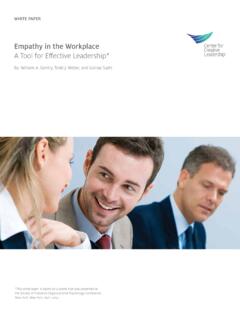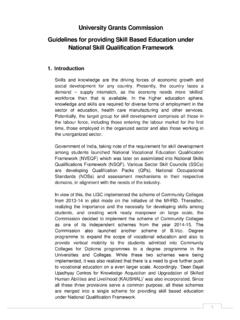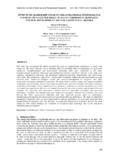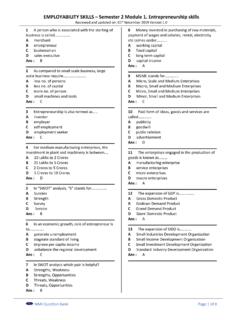Transcription of Critical thinking skill development
1 37 Changwong, K., Sukkamart, A., & Sisan, B. (2018). Critical thinking skill development : Analysis of a new learning management model for Thai high schools. Journal of International Studies, 11(2), 37-48. Critical thinking skill development : Analysis of a new learning management model for Thai high schools Ken Changwong King Mongkut s Institute of Technology Ladkrabang (KMITL), Bangkok, Thailand Aukkapong Sukkamart King Mongkut s Institute of Technology Ladkrabang (KMITL), Bangkok, Thailand Boonchan Sisan King Mongkut s Institute of Technology Ladkrabang (KMITL), Bangkok, Thailand Abstract. Under the vision outlined in Thailand , Critical thinking skills have become one of the key pillars of a new, knowledge-based economy. However, the 2015 Thailand Research Fund study that evaluated the logical thinking and analytical skills of 6,235 students in ten provinces of Thailand, found that the average score was , with only of all students passing.
2 Recognizing the severity of the crisis, nine experts met in August 2017 as a focus group and were tasked by the researchers to help with the development of a new Critical thinking learning management model. From this, a five-step learning management model was conceptualized, which the authors called the PUSCU Model . By means of cluster random sampling, 69 students were selected, from which two sub-groups were formed. One group of 35 experimental studies students, and one group consisting of 34 traditional learning students. The PUSCU model was tested for 16 weeks, from November 2016 through February 2017. The Statistical Package for the Social Sciences (SPSS) 21 software was used to conduct a one-way Multivariate Analysis Of Variance (MANOVA) to determine whether there were any differences between the control and the experimental groups.
3 The results indicated that the experimental group had higher average scores in terms of Critical thinking ability and academic achievement, and its members were satisfied with a high level of the model performance, particularly, with the instructor s use of the developed learning materials. Received: October, 2017 1st Revision: February, 2018 Accepted: May, 2018 DOI: Journal of International Studies Scientific Papers Foundation of International Studies, 2018 CSR, 2018 Journal of International Studies , , 2018 38 Keywords: Critical thinking , high-school students, learning management, secondary education, PUCSC model, Thailand JEL Classification: I20, I21, I23, I25 1. INTRODUCTION Preparing students to be able to think critically is one of the key goals for many professionals in higher education, and it is also a quality sought by most employers of university graduates (Sulaiman, Rahman, & Dzulkifli, 2008).
4 Under a Thailand vision, Critical thinking skills are stated to be a key pillar among the goals for a new, knowledge-based economy (Jones & Pimdee, 2017). These skills , however, are limited, as according to a recent study evaluating logical thinking and analytical skills , of 6,235 students in ten Thai provinces, the average final score was just , with only passing the exam (Rujivanarom, 2016). Over 2,500 years ago Plato in his discussions of logic indicated that Critical thinking is the tool that helps individuals find answers or solutions to a person s confusions and problems (Thayer-Bacon, 1998). Socrates, Plato s teacher, believed that discussion and Critical thinking with knowledge reside in the mind of the individual, rather than a teacher transmitting knowledge to a student (Ornstein & Levine, 2006). Nearly 2,500 years later, scholars and educators are still discussing the mechanisms, importance, and outcomes of Critical thinking skills (or lack thereof).
5 Contemporary evidence of the importance of Critical thinking skills for employment has been provided from the National Association of Colleges and Employers [NACE] (2016) which indicated that Critical thinking /problem-solving skills were ranked most important by the 144 surveyed employers (Table 1). This is also consistent with the research results obtained by Bassham, Irwin, Nardone, and Wallace (2013) which indicated that college education is responsible for the development of Critical thinking skills which, in their turn, lead to higher-order thinking . This is also consistent with (Costa & Kallick, 2014) who stated that Critical thinking skills are consistently included in all the lists of essentials behind college and career readiness (Kraisuth & Panjakajornsak, 2017). Table 1 How Employers Rate Career Readiness Competencies in Terms of Their Essential Need Competency Essential Need Rating 2016 Critical thinking /Problem Solving Professionalism/Work Ethics Teamwork/Collaboration Oral/Written Communication Information Technology Application Leadership Career Management Note.
6 Weighted average. Rated on the 5-point scale where 1 = Not essential; 2 = Not very essential; 3 = Somewhat essential; 4 = Essential; 5 = Absolutely essential. Source. Job Outlook 2016 Spring Update (National Association of Colleges and Employers, 2016). Many scholars and studies have also discussed the importance of Critical thinking skills in the context of 21st Century education and workforces (Geertsen, 2003). Barrington, Casner-Lotto, and Wright (2006), Ken Changwong, Aukkapong Sukkamart, Boonchan Sisan Critical thinking skill development : Analysis of a new learning management model .. 39 also discussed Critical thinking education in the context of students abilities to enter a modern, 21st century workforce. Reeve (2016) also pointed out the importance of 21st century and Critical thinking skills needed by Thai students for their technical and vocational education and training (TVET).
7 This is consistent with Chaiyasut, Samuttai, Phuwiphadawa, and Inthanet (2014), who indicated that Critical thinking is one of the 13 life-long learning indicators. The Organisation for Economic Co-operation and development (OECD) and the United Nations Educational, Scientific and Cultural Organization (UNESCO) (OEC/UNESCO, 2016) reviewed Thai education policy and concluded that information and communication technologies (ICT) should be used in problem-solving and Critical thinking more. Directives of the European Union (2015) also mention the urgent need for high-quality knowledge, skills , and competences developed through life-long learning, which focuses on learning outcomes for employability, innovation, active citizenship, and well-being. Siemens (2005) discussed connectivism and its meaning in the digital age and the half-life of knowledge, which was defined as the time span from when knowledge is gained to when it becomes obsolete, with the amount of knowledge doubling every 18 months.
8 Connectivism is therefore driven by the understanding that decisions are based on rapidly altering foundations. New information is continually being acquired. The ability to draw distinctions between important and unimportant information is vital ( Critical thinking ). The ability to recognize when new information alters the landscape based on the decisions made yesterday, is also Critical . Costa and Kallick (2014) researched what is Critical thinking and what is blocking its widespread teaching, transferring, and assessing in the 21st Century Classrooms? The answer from their research indicated that Critical thinking is a mental process. From this, individuals need to actively and skillfully conceptualize, apply, analyze, synthesize, and evaluate information to reach an answer or conclusion. From the above overview on the importance of Critical thinking skills , the researchers sought out to conceptualize a learning management model of the factors important for the enhancement of Critical thinking skills of Thai high school students.
9 Statement of the problem The recognition of the importance of Critical thinking abilities dates back over 2,500 years to Plato, with numerous scholars having discussed the importance of Critical thinking in education (Dewey, 1910; Galinsky, 2010; Paul & Elder, 2008, 2014a, 2014b; Paul, Elder, & Bartell, 1997; Sternberg, 1997). Added to this volume of work, many contemporary studies have discussed the importance of Critical thinking in a 21st Century workforce and in a knowledge-based economy (European Union, 2015; Jones & Pimdee, 2017; National Association of Colleges and Employers [NACE], 2016; OECD/UNESCO, 2016; Reeve, 2016). Under the Thailand initiative, Critical thinking and innovation are key pillars for future growth, prosperity, and a better quality of life. Therefore, the researchers undertook a study to develop a new learning management model to help guide educators in the development and evaluating of Thai high school student Critical thinking skills .
10 2. LITERATURE REVIEW The ability to think critically has been identified as an essential life skill (Galinsky, 2010), with current literature revealing that explicit instruction in, and practice of, Critical thinking strategies in the high school classroom can improve student academic performance (Hove, 2011). UNICEF, UNESCO and WHO list problem solving and Critical thinking as two of ten core life skill strategies and techniques (UNODC, n/d; World Health Organization, 1999). Journal of International Studies , , 2018 40 For philosophical teachers, the role model is Socrates, for whom education was nothing less than an examination of life itself (Paul et al., 1997). Over 2,500 years ago, Socrates taught in a non-dogmatic fashion, subjecting the ideas of his students to rigorous, Critical questioning (Taylor, 2012). The goal of this process was two-fold: to show them that they didn't know what they thought they did and to push them into critically examining their ideas for themselves.






